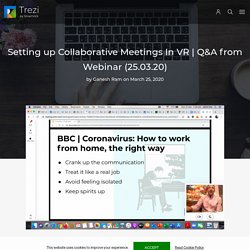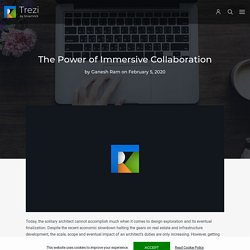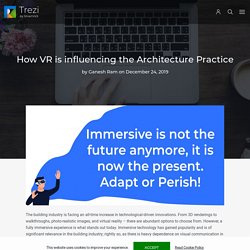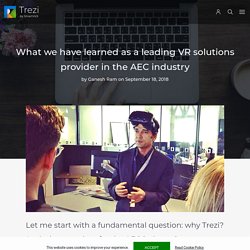

Trezi VR
Trezi is an immersive VR product for the AEC industry enabling designs from 3D modeling software & architecture software to be experienced collaboratively in real-time.
VR Software for Architects & Interior Designers - Trezi. Veda Prakash Nidumolu.

Partner with India's first VR Platform for AEC - Trezi. Trezi’s partnership with HP India works at multiple levels: to start with, it enables Trezi users to avail HP Reverb devices at exclusive prices.

At ID 2020, the country's best luxury design week, collaborating with HP, we presented our vision of a collaborative and futuristic workspace for architects and designers – an agile, forward-thinking studio for the design practices of tomorrow, as much a space to create as it is a place to inspire. Running in tandem with HP’s Office Of The Future campaign, we conceptualized the Studio Of The Future – powered primarily by Immersive Technology.
We also collaborate with HP regularly to organize online and offline events for VR enthusiasts in AEC. Trezi’s partnership with HP India works at multiple levels: to start with, it enables Trezi users to avail HP Reverb devices at exclusive prices. VR Platform for Training Architecture and Design Students - Trezi. Veda Prakash Nidumolu Head, Engineering.

Virtual Catalogs for Building Product Manufacturers - Trezi. Veda Prakash Nidumolu Head, Engineering A problem solver at heart, Veda graduated from BITS Pilani with a Bachelors in Electronics and a Masters in Mathematics.

He has over 10 years of experience in designing and developing highly scalable, available and performant systems, leading teams in UI, back-end, QA and Devops. Virtual Reality (VR) for Architects & Designers - Trezi. Veda Prakash Nidumolu Head, Engineering.

Trezi – Trezi’s Expanded Platform now bridges Architects with Product Manufacturers, Enables Students to be Future-ready. The year 2020 has impacted every single individual across industries and geographies.

And it has been no different for the AEC industry which has been hit hard by the COVID19-triggered global economic slowdown. In such a situation, faced by near extinction, many organisations have struggled to survive. Trezi – Setting up Collaborative Meetings In VR. In our first webinar to demonstrate the ease and efficacy of Trezi’s remote collaboration capabilities for the building AEC industry, Darren and Praveen conducted an online walk-through for attendees from around the world and shared tips on how to make remote collaborative effective and efficient!

We’re pleased with the insightful and interactive session made possible by the nearly 100 attendees who joined us this morning – and we’ll be back with more!. Missed it? Catch the webinar in full here, or access summarized insights from the session from this Q&A. How can my clients join a virtual collaborative meeting on Trezi, if they don’t own the software or the accessories? Your client doesn’t need to buy the software in order to use it for a specific meeting that you have invited them to – attendees that are not current subscribers are granted a licence for use during the meeting’s date and time.
Is there an upper-limit on the number of people who can join a virtual meeting on Trezi? Trezi – The Power of Immersive Collaboration. Today, the solitary architect cannot accomplish much when it comes to design exploration and its eventual finalization.

Despite the recent economic slowdown halting the gears on real estate and infrastructure development, the scale, scope and eventual impact of an architect’s duties are only increasing. However, getting all the participants of a project in the same place, or even on the same page is not an easy task! Every hour that is spent on coordination between different stakeholders is the time that is taken away from delivering an error-free project and is hence a poor investment of a project’s resources. This chaos in communication and time that is lost in finding an effective collaboration process has led to the need for technology-based intervention. Trezi – How VR is influencing the Architecture Practice.
The building industry is facing an all-time increase in technological-driven innovations.

From 3D renderings to walkthroughs, photo-realistic images, and virtual reality – there are abundant options to choose from. However, a fully immersive experience is what stands out today. Immersive technology has gained popularity and is of significant relevance in the building industry; rightly so, as there is heavy dependence on visual communication in design. How Trezi has evolved from providing VR solutions in AEC.
Let me start with a fundamental question: why Trezi?

And why a product for the AEC industry? Hi. To answer your question, SmartVizX, the organization that created Trezi, has intrinsically been an architecture and design-focused company since its inception. Both Tithi and I are architects with over four decades of combined experience. The problems we are solving are actually problems we have faced right through our professional careers. VR software made by architects, for architects. SmartVizX is a company founded by two experienced architects, Gautam and Tithi, who have a combined experience of more than 40 years. As a result, we have a first-hand experience of the problems faced by the AEC industry and aim to solve that with Trezi which uses virtual reality in architecture, construction, and engineering to change the design experience for all stakeholders in the industry.
Right from collaboration issues between stakeholders arising due to the absence of a single version of the truth to the difficulty in effectively communicating design intent, it has been pretty clear that the community, as a whole, is in urgent need of a solution that aims to resolve the innate problems existing currently within the AEC industry. Building product manufacturers use VR & 3D software. The architecture, engineering and construction (AEC) industry consist of multiple stakeholders working together to bring a project to fruition. Building product manufacturers and suppliers play a crucial role in supporting architects and designers. Traditionally, building product manufacturers and suppliers have reached out to design and architecture firms through a tedious process of marketing that includes preparing, stocking and distributing samples and catalogs which regularly became outdated with the introduction of new product lines, creating multiple physical mockups, and organizing lunch-and-learn sessions at their premises to showcase their products to architects and designers.
This process has led to a lot of wastage in time and costs, as well as loss of additional revenue opportunities. Most smaller suppliers have found it difficult to showcase their products to larger design firms due to limited marketing budgets. 3D architectural software + immersive solves AEC challenges. Technology has created significant efficiencies and opportunities to stretch the boundaries of productivity and possibility across every industry.
The limitations faced by businesses until recently form today’s foundation of radical disruption. Industries are fast adopting and inculcating these new technologies into their regular business operations, enhancing customer experience, increasing productivity and challenging the status quo of their respective industries. The AEC industry is no different. One of the technologies revolutionizing the AEC space today is virtual reality (VR). VR helps architects communicate design intent better. As a practicing architect, I often found it difficult to communicate design intent to our clients. While working on a building project, we often used 3D modeling softwares/authoring tools but communicated the schematic and conceptual designs to clients and other stakeholders by generating 2D static renderings from fixed viewpoints on paper, Powerpoint presentations or renders on a flat computer screen.
I realized that what we visualize, understand, interpret and absorb from these traditional tools to communicate design intent – the images on our screen, the 2D static renders, or the floorplans and elevations on paper – are often disconnected from the reality of what’s planned to be built inside and outside of the front door, and none of the architecture software programs available could solve this problem. Immersive 3D rendering software tech arrives. The purpose of being at AIA and NeoCon was quite clear for the Trezi team. While we might have been operating from our founder-based bias in terms of the relevance of emerging tech like VR in the AEC industry and feeling excited about good quality traction building in India, the primary reason to attend these events was to see and understand, firsthand, how the world is responding to immersive tech.
And both events brought tremendous learnings and validations, too. The startup section at AIA was undoubtedly the busiest and over 80% of the companies displaying their tech products had an immersive offering in their products. It became evident, very quickly, what the future holds. Heck no. BIM to 3DS Max to VR was one of the last sessions at AIA, it was also among the busiest. NeoCon, despite being a product-centric event, saw a fair presence (and high-interest levels) of tech-based startups as well. So, the purpose of being at AIA and NeoCon was well achieved. Heck no. 3D modelling software improves collaboration in AEC.
The AEC design environment is characterized by its reliance on multifarious collaborating parties spread across many different organizations and the entire project delivery lifecycle. Trezi – Disruptive Design Communication through VR. Today, technological advancements enable us to work remotely and still be connected in real-time. Trezi – Virtual Reality is the future of architecture and construction. Most people believe the construction process is an organized, linear and predictable phenomenon planned top-down into design, contracts and execution packages. Trezi - Virtual Reality (VR) architecture & design software.